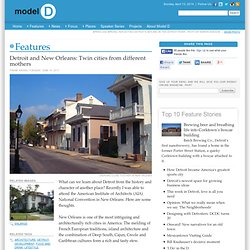

Research & Resources. Community Groups & Crowdsourcing. Communications. Planning. Maps. Dream City. Is Gentrification Always Bad for Revitalizing Neighborhoods? - Neighborhoods. I undertake today’s topic with more than a little trepidation, since it is by its nature emotionally and, not infrequently, racially charged.

The title is deliberately chosen but somewhat rhetorical, since the answer ultimately depends on one's definition. Most urban thinkers agree that the massive abandonment and resulting disinvestment of large areas of our cities by the (largely white) middle class, beginning in the 1960s and only now beginning to be reversed in many places, was terrible for cities, for populations left behind, and for the environment. But many residents whose families remained through those years of disinvestment and until the present day are understandably fearful that addressing these problems by bringing new residents and economic activity into their neighborhoods will only benefit the newcomers while disadvantaging the existing community. The biggest fear is that current residents will be displaced to make room for redevelopment. “[F]or the past 20 years . . .
Detroit and New Orleans: Twin cities from different mothers. Frank Arvan | Tuesday, June 14, 2011 Creating close togther in New Orleans Related Images What can we learn about Detroit from the history and character of another place?

Recently I was able to attend the American Institute of Architects (AIA) National Convention in New Orleans. Here are some thoughts. New Orleans is one of the most intriguing and architecturally rich cities in America. Detroit is equally interesting but in many different ways. New Orleans is dedicated to urban life. Detroit's economy has been and still is dominated by the auto industry. That has not been the tradition in Detroit. Both cites have a storied musical legacy. These comparisons are useful because they show that each place grows out of conditions, accidents and decisions that form its authentic character.
House & Home - Liveable v lovable. Vancouver is Hollywood’s urban body double.

It is famously the stand-in for New York, LA, Seattle and Chicago, employed when those cities just get too tough, too traffic-clogged, too murderous or too bureaucratic to film in. It is almost never filmed as itself. That is because, lovely as it is, it is also, well ... a little dull. Who would want to watch a film set in Vancouver? To see its skyscrapers destroyed by aliens or tidal waves, its streets populated by cops and junkies, its public buildings hosting romantic reunions? No. The big cities it seems, the established megacities of the US, Europe and Asia are just too big, too dangerous, too inefficient. All the surveys use an index. So that’s the mountains, lakes and huge cups of generic coffee accounted for. To even begin to understand how these slightly unsettling results are arrived at, we need to understand who compiles them and who they are for. Joel Garreau, the US urban academic and author, agrees. New York. The Integration Initiative.
Detroit.